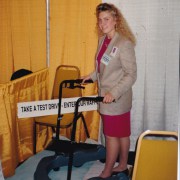Journey from Prototype to Production: Part 1
These are pictures of the first U-Step, circa 1992. This was a major step forward from the wooden prototype I had made a few years earlier. It’s easy to see from the base why we named it a U-Step: unlike today, where the base is squared out more to maximize stability, the original base was a perfect “U” shape. The first U-Step had a quarter-inch aluminum plate that was rolled into shape and welded together to form the base.
To create this model, I worked with Alan Woodhouse, an experienced tool and die maker from another era (who happened to be married to my cousin). Originally from England, Alan worked in a tool room during World War II, contributing to the war effort by making products engineers had designed for battle. Alan played a major role in helping make this version of the U-Step. The wheel configuration had three casters in front, two main turning wheels in the middle, and two more wheels in the back. This model had a tension control (the knob on the right handlebar) and it folded! My mother used this walker for many years until we developed a more refined model, and it worked well for her. She was for the most part independent in her home and the U-Step prevented her from falling.
Over time, we tried many different options on the U-Step. Some ideas were successful, while others were not, like trying to hide the cables inside the frame. I can honestly say that I earned my engineering degree on the job, and that my marketing degree was not so helpful in this area. In the original model, a single brake handle controlled the whole unit as it does today, but the brakes were set up differently. Squeezing the brake handle stopped the U-Step, unlike today, where it allows the unit to roll. The innovative braking system sported rim band brakes, similar to stopping machinery from spinning. I remember working with Alan for hours on connecting the brake cables. We used many bicycle components with the exception of Kevlar tubing and pulleys, and it was very difficult to set up. In fact, I remember hearing Alan express his frustration in that charming British accent. “You are trying to make a silk purse out of a sow’s ear!” And not five minutes later – success! It actually worked. Squeezing the one hand brake made the unit immediately stop. I think we were both in shock. Everything worked except the tension control, which needed more development. But the concept was there.
After nearly six months of development and $3,000 in production costs later, my mother had a presentable walker that was designed for her needs.
This in fact was the walker that my mother’s internist, Dr. Ira Weiss, saw her using. He reached out to me with a request to consider making it for others.
This was the first time I thought about making it into a business.
To be continued…












